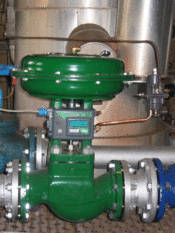Control valve
Control valves are valves used within industrial plants and elsewhere to control operating conditions such as pressure, temperature, liquid level and flow rate by fully or partially opening or closing in response to signals received from controllers that compare a "setpoint" to a "process variable" whose value is provided by independent sensors that monitor changes in such conditions.[1]
Control valves are an integral part of the hundreds (or even thousands) of control loops networked together in industrial plants to produce their various endproducts.
A control valve is part of an assembly that typically includes a valve body (and its internal parts), an actuator to provide the motive power for opening and closing the valve, and a variety of additional accessories such as positioners, transducers, manual operators and limit switches.[2] The motive power provided by the actuators may be electrical, hydraulic or pneumatic.
Applications
Control valves are used in industries such as petroleum refining, chemical and petrochemical manufacturing, nuclear power plants and fossil fuel power plants, natural gas processing and many others.
In such industries, control valves are an essential component of the systems used to control important operational parameters like pressure, temperature, liquid levels and flow rates.
Pressure control valves may be used to reduce liquid or gas pressures or they may be used to maintain a back-pressure (i.e., a pressure upstream of the valve). They may also be used to maintain a pressure difference between two points in a process.
Temperature control valves are used to maintain liquid or gas temperatures within process vessels or to control the heat transfer within heat exchangers and process heaters or furnaces.
Level control valves are used to maintain liquid levels within a desired range in process vessels or tanks. In some cases, they may also be used to maintain levels of solid particles.
Flow control valves are used to control the volumetric or mass flow rate of liquids and gases. They may also be used to maintain a desired ratio between two flows, in which case they are part of what is called a flow ratio controller.
Types of control valve
The different types of control valve may be categorized as shown below:
- Conventional valve
- Severe service valve
- Pressure independent control valve
Types of control valve bodies
The different types of control valve bodies include:[2]
- Angle valves
- Cage-style valve bodies
- Angle seat piston valves
- Globe valves
- Single-port valve bodies
- Balanced-plug cage-style valve bodies
- High capacity, cage-guided valve bodies
- Port-guided single-port valve bodies
- Double-ported valve bodies
- Three-way valve bodies
- Rotary valves
- Butterfly valve bodies
- V-Notch ball control valve bodies
- Eccentric-disk control valve bodies
- Eccentric-plug control valve bodies
References
- ↑ Bela G. Liptak (Editor) (2003). Instrument Engineers' Handbook, 4th Edition. CRC Press. 0-8493-1083-0.
- ↑ 2.0 2.1 Fisher Controls International Control Valve Handbook
